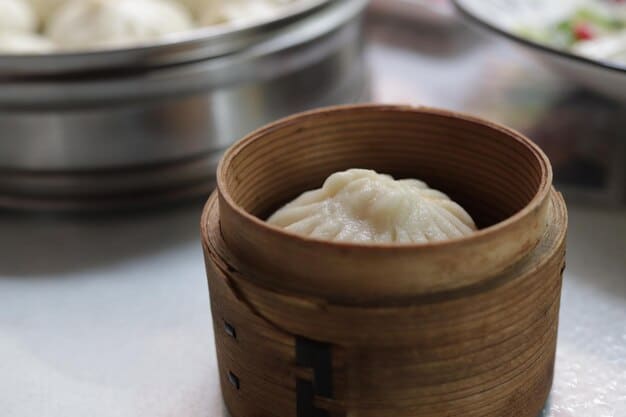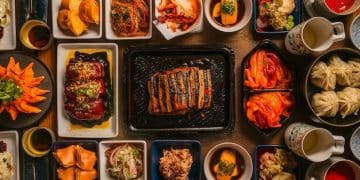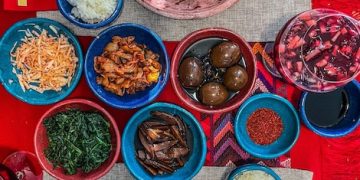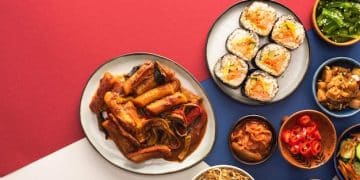Chinese Drama Food Culture: A Culinary Journey Through Your Favorite Shows

Advertisements
Chinese Drama Food Culture: A Culinary Journey Through Your Favorite Shows explores the significant role of food in Chinese dramas, showcasing how it reflects cultural values, enhances storytelling, and influences audience perception, making each drama a unique culinary experience.
Immerse yourself in the captivating world of Chinese dramas, where compelling stories are interwoven with mouthwatering culinary delights. Explore the unique intersection of Chinese Drama Food Culture: A Culinary Journey Through Your Favorite Shows, where food transcends mere sustenance and becomes a powerful narrative tool.
Anúncios
The Art of Food in Chinese Dramas
Food in Chinese dramas is not just a prop; it’s an integral part of the storytelling. From family gatherings to romantic dinners, the dishes depicted reflect the characters’ emotions, relationships, and cultural backgrounds.
Understanding the symbolism behind these culinary choices can greatly enhance your viewing experience, adding layers of depth and meaning to each scene.
Anúncios
Symbolism and Significance
Chinese cuisine is rich with symbolism. Specific dishes are often associated with particular events or emotions, subtly conveying messages to the audience. For instance:
- Dumplings (Jiaozi): Represent wealth and prosperity, often eaten during Lunar New Year celebrations.
- Noodles (Changshou Mian): Symbolize longevity and are traditionally served on birthdays.
- Tangerines: Represent good luck and fortune, commonly given as gifts during festive occasions.
Recognizing these symbols enables viewers to appreciate the cultural nuances embedded within the dramas.
Emotional Connection
Food scenes are often used to create emotional connections between characters. Sharing a meal can signify intimacy, reconciliation, or familial bonds. Consider the following examples:
- Family Dinners: Showcase harmony and unity within a family, highlighting the importance of togetherness.
- Romantic Dates: Emphasize affection and deepening relationships, using food as a means of expressing care.
- Comfort Food: Provides solace and healing during times of distress, illustrating the nurturing power of food.
These moments resonate deeply with audiences, enhancing the emotional impact of the drama.
In conclusion, the use of food in Chinese dramas goes beyond mere aesthetics; it serves as a conduit for cultural values and emotional expression, enriching the narrative fabric of the stories.
Popular Dishes Featured in Dramas
Many Chinese dramas showcase a wide array of delectable dishes that are not only visually appealing but also steeped in culinary tradition. These dishes often become associated with the dramas themselves, generating curiosity and interest among viewers.
Exploring the recipes and stories behind these popular dishes can provide a deeper appreciation for Chinese culture and cuisine.

Peking Duck (北京烤鸭)
Peking Duck is a quintessential Chinese dish known for its crispy skin and tender meat. Its elaborate preparation and presentation make it a symbol of luxury and celebration.
The dish often appears in dramas to signify special occasions or to demonstrate the affluence of the characters.
Hot Pot (火锅)
Hot pot is a communal dining experience where diners cook various ingredients in a simmering pot of broth. It symbolizes togetherness and is often featured in dramas to depict family gatherings or friendly get-togethers.
The customizable nature of hot pot allows for a wide range of ingredients, reflecting the diversity of Chinese cuisine.
Mapo Tofu (麻婆豆腐)
Mapo Tofu is a spicy and flavorful dish from Sichuan cuisine, known for its bold flavors and numbing sensation. It is often depicted in dramas to represent the resilience and strength of the characters.
- Fiery Taste: Reflects the intensity of emotions or situations faced by the characters.
- Comforting Texture: Provides a sense of warmth and satisfaction, offering solace in difficult times.
- Cultural Significance: Showcases the culinary heritage of Sichuan province, adding regional flavor to the drama.
These dishes, among others, are frequently showcased in Chinese dramas, representing the rich tapestry of Chinese culinary traditions.
Regional Cuisine and Storytelling
Chinese dramas often highlight the diverse regional cuisines of China, providing viewers with a glimpse into the unique culinary traditions of different provinces and cities.
This regional focus not only enriches the storytelling but also educates audiences about the geographical and cultural diversity of China.
Sichuan Cuisine
Sichuan cuisine is renowned for its bold and spicy flavors, characterized by the use of chili peppers and Sichuan peppercorns. Dramas set in Sichuan often feature dishes like Mapo Tofu and Kung Pao Chicken, showcasing the region’s culinary identity.
These dishes are not only delicious but also reflective of the region’s vibrant and passionate culture.
Cantonese Cuisine
Cantonese cuisine, originating from Guangdong province, is known for its emphasis on fresh ingredients and delicate flavors. Dramas set in Guangzhou or Hong Kong often feature dishes like dim sum and roast meats, highlighting the region’s culinary sophistication.
- Dim Sum: A variety of bite-sized portions served with tea, perfect for sharing and socializing.
- Roast Meats: Crispy and flavorful meats, often prepared using traditional techniques.
- Seafood: Fresh and abundant seafood, reflecting the region’s proximity to the coast.
These dishes contribute to the overall atmosphere of the dramas, reflecting the region’s unique cultural landscape.
Shanghai Cuisine
Shanghai cuisine is characterized by its sweet and savory flavors, often incorporating soy sauce and sugar. Dramas set in Shanghai often feature dishes like Xiaolongbao (soup dumplings) and red-braised pork, showcasing the city’s culinary elegance.
- Xiaolongbao: Delicate soup-filled dumplings, requiring skill and precision to prepare.
- Red-Braised Pork: Tender and flavorful pork, braised in a sweet and savory sauce.
- Noodles: Served in a variety of styles, often incorporating local ingredients and flavors.
By showcasing these regional cuisines, Chinese dramas offer a rich and diverse culinary experience for viewers, broadening their understanding of Chinese culture.
Food as a Reflection of Social Status
In Chinese dramas, the food that characters consume often reflects their social status and economic standing. Lavish banquets, humble meals, and specific ingredients can all serve as indicators of wealth, power, or poverty.
Analyzing these culinary cues allows viewers to gain a deeper insight into the characters’ lives and their place within the social hierarchy.
Wealth and Luxury
Characters of high social status are often depicted enjoying extravagant meals featuring rare and expensive ingredients. These culinary displays underscore their affluence and power.
Examples include scenes featuring abalone, shark fin soup, or bird’s nest, all considered delicacies in Chinese cuisine.
Humble Origins
Conversely, characters from humble backgrounds are often shown consuming simple and affordable meals, such as rice porridge or steamed buns. These dishes reflect their limited resources and everyday struggles.

Such scenes highlight the stark contrast between the lives of the wealthy and the poor, adding social commentary to the dramas.
Symbolic Dishes
Certain dishes can also symbolize a character’s social aspirations or their desire for upward mobility. Consider a character ordering an expensive dish that they cannot afford, signaling their ambition to climb the social ladder.
- Display of Affluence: Using food to project an image of wealth and success.
- Social Mobility: Aspiring to consume higher-status dishes as a means of advancement.
- Cultural Identity: Maintaining traditional food practices to preserve cultural heritage.
Through these subtle culinary cues, Chinese dramas provide a nuanced portrayal of social dynamics and economic disparities.
In conclusion, the choice of food in Chinese dramas acts as a powerful indicator of socioeconomic status, greatly enriching the narrative depth and delivering social commentary.
The Influence of Food on Character Development
Food plays a significant role in influencing character development in Chinese dramas. The preferences, habits, and culinary skills of a character can reveal much about their personality, values, and emotional state.
Paying attention to these details can provide valuable insights into the motivations and transformations of the characters.
Food Preferences
A character’s food preferences can reflect their personality traits. For example, a character who enjoys spicy food might be portrayed as adventurous and daring, while one who prefers bland dishes might be seen as cautious and reserved.
These preferences serve as subtle cues, helping viewers to understand the characters’ underlying personalities.
Culinary Skills
A character’s culinary skills can also reveal their nurturing and caring nature. A character who is skilled in cooking might be portrayed as a loving and supportive figure within their family or community.
- Nurturing Role: Using cooking to express care and affection for others.
- Emotional Expression: Channeling emotions into the creation of culinary masterpieces.
- Cultural Connection: Preserving and passing on traditional recipes and cooking techniques.
These culinary abilities enhance the character’s depth and complexity, making them more relatable and sympathetic.
Food and Relationships
The way characters interact with food can also reflect their relationships with others. Sharing a meal, cooking together, or even arguing over food can reveal the dynamics of their relationships and their emotional connections.
- Building Bonds: Using food as a means of strengthening relationships and fostering intimacy.
- Resolving Conflicts: Sharing a meal to mend fences and promote reconciliation.
- Cultural Identity: Maintaining traditional food practices to preserve cultural heritage.
In summary, food profoundly impacts character development in Chinese dramas, enriching the narrative and offering a fascinating lens through which to understand human nature.
Ultimately, the culinary nuances portrayed in Chinese dramas serve as a window into character depths and relational subtleties, enhancing the viewer’s investment in the storyline.
Modern Trends and Culinary Innovations
Modern Chinese dramas often incorporate contemporary culinary trends and innovations, reflecting the evolving tastes and lifestyles of the younger generation.
These dramas not only showcase traditional dishes but also highlight the fusion of Chinese cuisine with international flavors, offering a fresh and dynamic perspective on Chinese food culture.
Fusion Cuisine
Fusion cuisine, which combines elements of different culinary traditions, is increasingly featured in modern Chinese dramas. This trend reflects the growing influence of globalization and the desire to experiment with new flavors and techniques.
Examples include dishes that blend Chinese ingredients with Western cooking methods, creating unique and innovative culinary experiences.
Food Presentation
Modern dramas place a greater emphasis on food presentation, showcasing beautifully plated dishes that are visually appealing. This trend reflects the growing popularity of food photography and social media, where aesthetic appeal is highly valued.
- Artistic Plating: Arranging food in a visually stunning manner to enhance its appeal.
- Social Media Influence: Showcasing dishes that are photogenic and shareable on social media platforms.
- Culinary Innovation: Experimenting with new ingredients and techniques to create unique and memorable dining experiences.
Healthy Eating
With increasing awareness of health and wellness, modern Chinese dramas are also incorporating healthier food options and dietary preferences. This reflects the growing concern for nutrition and the desire to promote a balanced lifestyle.
- Organic Ingredients: Using locally sourced and organic ingredients to promote sustainability and health.
- Plant-Based Options: Featuring vegetarian and vegan dishes to cater to diverse dietary preferences.
- Mindful Eating: Emphasizing the importance of savoring each bite and practicing mindful consumption.
These modern trends and culinary innovations add a contemporary twist to Chinese drama food culture, making it relevant and engaging for today’s audiences.
In essence, the integration of contemporary trends ensures that Chinese dramas remain at the forefront of culinary representation, appealing to both traditionalists and modern food enthusiasts.
| Key Aspect | Brief Description |
|---|---|
| 🍜 Food Symbolism | Dishes represent emotions and cultural values. |
| 🥢 Popular Dishes | Peking Duck, Hot Pot, and Mapo Tofu are commonly featured. |
| 🌍 Regional Cuisine | Highlights diversity with Sichuan, Cantonese, and Shanghai dishes. |
| 💰 Social Status | Food choices reflect wealth or humble origins. |
Frequently Asked Questions (FAQ)
▼
Food is essential in Chinese dramas because it reflects cultural values, enhances storytelling, and creates emotional connections between characters. It’s not just sustenance but a narrative tool.
▼
Popular dishes include Peking Duck, symbolizing luxury; Hot Pot, representing togetherness; and Mapo Tofu, known for its spicy flavors. These dishes enrich the cultural context.
▼
Regional cuisine adds depth by showcasing the unique culinary traditions of different provinces, such as Sichuan’s spicy dishes or Shanghai’s sweet and savory flavors, enhancing the drama’s authenticity.
▼
Yes, food choices often indicate a character’s social and economic standing, with lavish meals representing wealth and simple dishes portraying humbler backgrounds, adding social commentary to the plot.
▼
Modern dramas incorporate fusion cuisine, artistic food presentations, and healthier eating options, reflecting contemporary lifestyles and global influences while still honoring traditional flavors.
Conclusion
In conclusion, the exploration of Chinese Drama Food Culture: A Culinary Journey Through Your Favorite Shows reveals the intricate connection between food, culture, and storytelling. From symbolic dishes to regional specialties, food in Chinese dramas enriches the narrative and offers a captivating glimpse into Chinese society and its evolving traditions.





